The Heloderm difference

How we train
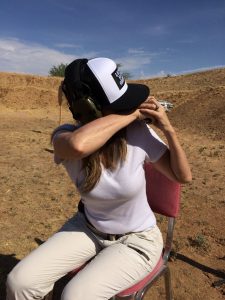 Our doctrine is flexible, adapting to emerging threats, and not “one size fits all.” Generally, we keep our classes small so we can tailor your instruction to your individual needs. For example, conventional shooting schools may make you an expert at drawing from a strong side belt holster–even if you, personally, will never carry your firearm in a belt holster. Likewise, other schools’ training may be geared toward operation of high-capacity, semi-automatic pistols, which are good fighting tools, but the skills to use them may or may not translate well to the snubby revolver or pocket pistol you will actually have on you when you get mugged.
Our doctrine is flexible, adapting to emerging threats, and not “one size fits all.” Generally, we keep our classes small so we can tailor your instruction to your individual needs. For example, conventional shooting schools may make you an expert at drawing from a strong side belt holster–even if you, personally, will never carry your firearm in a belt holster. Likewise, other schools’ training may be geared toward operation of high-capacity, semi-automatic pistols, which are good fighting tools, but the skills to use them may or may not translate well to the snubby revolver or pocket pistol you will actually have on you when you get mugged.
*****
Heloderm’s “Reverse” Approach to Firearms Training
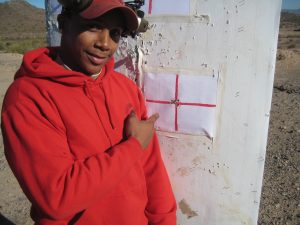 Most “tactical” training has its roots in the military or law enforcement, and Heloderm’s instructors have decades of law enforcement and military experience. That’s not a bad thing, but a heavily armed and armored SWAT operator with ammunition to spare, several equally armed friends, intel support, redundant communications systems, relatively abundant training, experience, and resources, and lots of time to plan the operation, has different options than an individual citizen in a parking garage late at night, or even a crowd of strangers in a nightclub that gets attacked. Accordingly, we must avoid a dogmatic “this is how we did it in the Marines” type attitude toward to your training.
Most “tactical” training has its roots in the military or law enforcement, and Heloderm’s instructors have decades of law enforcement and military experience. That’s not a bad thing, but a heavily armed and armored SWAT operator with ammunition to spare, several equally armed friends, intel support, redundant communications systems, relatively abundant training, experience, and resources, and lots of time to plan the operation, has different options than an individual citizen in a parking garage late at night, or even a crowd of strangers in a nightclub that gets attacked. Accordingly, we must avoid a dogmatic “this is how we did it in the Marines” type attitude toward to your training.
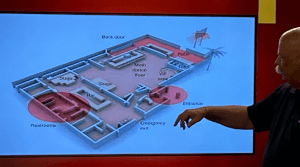
Likewise, most schools follow a marksmanship based approach to firearms training. Shooting small groups from a static position, or being able to hit a target far away, is how they measure marksmanship success. After you get good at that (and are programmed to plant your feet in a fight), you might have the option, at additional cost, to take other courses where you may learn “advanced” close range or movement skills. Marksmanship is important, and precision is sometimes essential, but in the real world, people rarely get assaulted from across the street.

So the first things you’ll learn from us are weapon retention, jamming his draw, and how to off-line and control HIS weapon so you live long enough to get to your own. We will teach you how to get off the “railroad tracks” of his line of attack. Later, you will train up to the precision you will need to take a head shot on the guy with a knife to your little girl’s throat, or how to take out an active shooter in a mall.
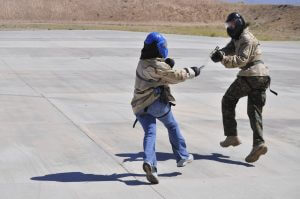
If you are standing in one place during a fight, you are probably doing something wrong. You most likely WILL stand in one place, perhaps at the cost of your life, if the vast majority of your “square range” training has already programmed your reflexes to do exactly that. Heloderm’s courses introduce effective, dynamic movement early on.

*****
Three Tiers of Training
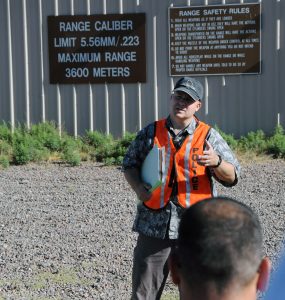
Usually, our process has three phases: Planning, Didactic, and Dynamic.
*****
Training Plan
In the first phase, our lead instructor speaks with you to find out what you need. You get to interview him, to see if we are a good fit for you, and you can tell him exactly what you or your group are looking for. George will ask you about your previous training, so we can tailor your instruction to build on your existing skill sets.
Didactic Training
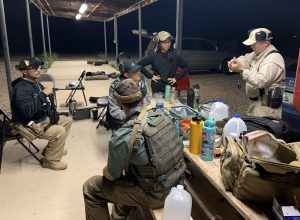
In decades of teaching crisis resolution skills, we’ve found that students who understand the WHY can work their way back to the HOW in an emergency. Concepts are more important than techniques. A foundation of safe operating habits is necessary, so you can be more dangerous to your enemies than to your friends. We will teach you ways you can safely train on your own, in your own home.
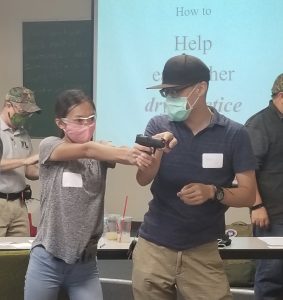
The didactic phase is far more than “death by PowerPoint.” You and family members or domestic partners can practice off-lining and disarming skills hands-on, before we do any live fire. You will learn how to solve line of fire problems with a weapon-mounted laser, looking over the sights of an inert simulator at a simulated “opponent” while interacting (from a safe distance) with “bystanders.”
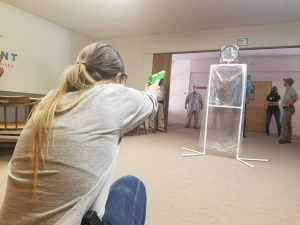
In a non-shooting class, such as Managing School Violence, this is where we will demonstrate minimum and maximum effective ranges, and practice with field expedient weapons.

You may learn limb-pins and other means of controlling the assailant(s) you subdued, without handcuffs.

We cover what to expect when law enforcement arrives, and how not to get shot by the good guys and gals. The second phase can take place in your home, school, church, or workplace, so as a team we can help you develop tactics appropriate to the micro-terrain you will likely be in, when death comes to your door.
Dynamic Phase
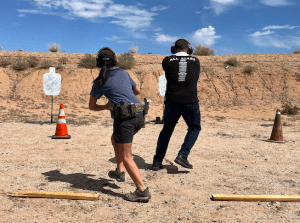
 In a Firearms class, the Dynamic phase is when we go to a range to verify, with live fire, that the skills you have already learned “dry” are working. We practice body indexed, target focused shooing methods, as well as sighted precision fire. You will get to test your gear in addition to your skills.
In a Firearms class, the Dynamic phase is when we go to a range to verify, with live fire, that the skills you have already learned “dry” are working. We practice body indexed, target focused shooing methods, as well as sighted precision fire. You will get to test your gear in addition to your skills.
Your loved ones can learn to become part of the solution, rather than part of the problem. We don’t just teach you to pull a trigger. We practice protocols for after your (first) assailant is down. Can you reach your cell phone with your non-shooting hand? You’ll need to, because we practice communication with 911, gun in hand, on the range, along with other Wyatt (post shooting) protocols.
*****
Hooded drills build your confidence in non-diagnostic flow chart stoppage reduction, and allow us to set up “shoot / don’t shoot” threat discrimination scenarios.
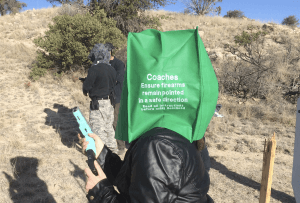
*****
In a Managing School / Church / Workplace Violence class, we do scenario based, team exercises. Because groups tend to follow leaders in crises, you will take turns being “the only one here who has taken this course.” We will show you how to delegate essential roles to bystanders who may need a “mission,” if they are to function at all.
During the dynamic phase, we can also get messier with improvised weapons and distraction devices.
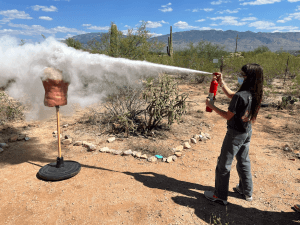

*****
In a First Aid / CPR / AED class, this phase might include a mass-casualty, triage and treatment exercise using readily available materials such as clothing in lieu of a first aid kit. As with the Managing Violence classes, you will learn how to lead a group with mixed, or few, medical skills to unified, productive effort.

